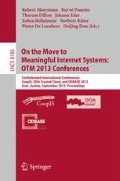Abstract
In order to discover and compose relevant Web services, most Web service composition approaches require users to describe composition requirements and constraints in formal expressions. However, requirements still focus on the technical level as they require domain-specific knowledge on functional and non-functional properties. As a matter of fact, the gap between users’ high-level requirements describing business objectives and composition requirements remains a challenge in Web service composition. In this paper, we propose an end-to-end transformation approach to build a set of technical composition requirements from user high-level requirements, which are specified by an English-structured language to capture business objectives, and to specify actions that Web services can achieve.
Access this chapter
Tax calculation will be finalised at checkout
Purchases are for personal use only
Preview
Unable to display preview. Download preview PDF.
References
Dustdar, S., Schreiner, W.: A Survey On Web Services Composition. International Journal of Web and Grid Services 1, 1–30 (2005)
OASIS Reference Model for Service Oriented Architecture 1.0 (2006), http://www.oasis-open.org/committees/download.php/19679/soa-rm-cs.pdf
Jazuli Bin Kamarudin, N., Sani, N.F.M., Atan, R.: Transformation from requirement into behavior design: A review. In: 2012 International Conference on Information Retrieval & Knowledge Management (CAMP), pp. 153–157 (2012)
Yue, T., Briand, L.C., Labiche, Y.: A Systematic Review of Transformation Approaches Between User Requirements and Analysis Models. Requirements Engineering 16, 75–99 (2011)
Grünbacher, P., Egyed, A., Medvidovic, N.: Reconciling Software Requirements and Architectures With Intermediate Models. Software and Systems Modeling, 235–253 (2004)
Fliedl, G., Kop, C., Mayr, H.C., Salbrechter, A., Vöhringer, J., Weber, G., Winkler, C.: Deriving Static and Dynamic Concepts from Software Requirements Using Sophisticated Tagging. Data Knowledge Engineeriong 61, 433–448 (2007)
Subramaniam, K., Liu, D., Far, B.H., Eberlein, A.: UCDA: Use Case Driven Development Assistant Tool for Class Model Generation. In: 16th International Conference on Software Engineering and Knowledge Engineering (SEKE 2004), Banff, Canada (2004)
Samarasinghe, N., Somé, S.: Generating a Domain Model from a Use Case Model. In: Proceedings on Intelligent and Adaptive Systems and Software Engineering (2005)
Mukhopadhyay, D., Chougule, A.: A Survey on Web Service Discovery Approaches. In: Wyld, D.C., Zizka, J., Nagamalai, D. (eds.) Advances in Computer Science, Engineering & Applications. AISC, vol. 166, pp. 1001–1012. Springer, Heidelberg (2012)
Roman, D., de Bruijn, J., Mocan, A., Lausen, H., Domingue, J., Bussler, C., Fensel, D.: WWW: WSMO, WSML, and WSMX in a nutshell. In: Mizoguchi, R., Shi, Z.-Z., Giunchiglia, F. (eds.) ASWC 2006. LNCS, vol. 4185, pp. 516–522. Springer, Heidelberg (2006)
Martin, D., Paolucci, M., Wagner, M.: Towards Semantic Annotations of Web Services: Owl-S from the SAWSDL Perspective. In: Proceedings of the OWL-S Experiences and Future Developments Workshop at ESWC (2007)
Bhiri, S., Derguech, W., Zaremba, M.: Web Service Capability Meta Model. In: WebIST 2012, pp. 47–57 (2012)
Fayoumi, A., Yang, L.: SBVR: Knowledge Definition, Vocabulary Management, and Rules Integrations. International Journal of E-Business Development (2013)
Meditskos, G., Bassiliades, N.: Structural and Role-Oriented Web Service Discovery with Taxonomies in OWL-S. IEEE Transactions on Knowledge and Data Engineering 22, 278–290 (2010)
Li, W., Badr, Y., Biennier, F.: Service farming: An Ad-Hoc and Qos-Aware Web Service Composition Approach. In: Proceedings of the 28th Annual ACM Symposium on Applied Computing, pp. 750–756. ACM, New York (2013)
Author information
Authors and Affiliations
Editor information
Editors and Affiliations
Rights and permissions
Copyright information
© 2013 Springer-Verlag Berlin Heidelberg
About this paper
Cite this paper
Li, W., Badr, Y., Biennier, F. (2013). Improving Web Service Composition with User Requirement Transformation and Capability Model. In: Meersman, R., et al. On the Move to Meaningful Internet Systems: OTM 2013 Conferences. OTM 2013. Lecture Notes in Computer Science, vol 8185. Springer, Berlin, Heidelberg. https://doi.org/10.1007/978-3-642-41030-7_21
Download citation
DOI: https://doi.org/10.1007/978-3-642-41030-7_21
Publisher Name: Springer, Berlin, Heidelberg
Print ISBN: 978-3-642-41029-1
Online ISBN: 978-3-642-41030-7
eBook Packages: Computer ScienceComputer Science (R0)

